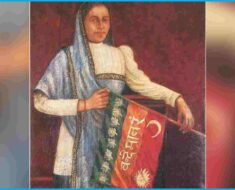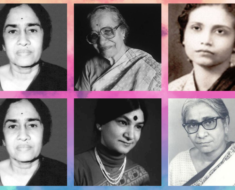The Indian freedom struggle is replete with stories of courage, commitment, unwavering resolve and
resilience displayed by extraordinary men and women of our country who gave their all for the cause
of freedom.
Although this saga is lined with a galaxy of heroes, yet very few shine brighter than Punjab Kesari, Lala Lajpat Rai- The Lion of Punjab.
He was a towering freedom fighter, anastute social reformer, an avid journalist and a thought provoking writer. The title Punjab Kesari pays homage to his fearless lion like nature and indomitable spirit.
Early Life and Education
Lala Lajpat Rai was born on 28 th January, 1865 at Dhudike in Faridkot district of British era Punjab to
Munshi Radha Krishna, an Urdu teacher at Govt, school Rewari, Punjab and Gulab Devi. He did his
initial schooling from the same school where his father was teaching.

Thereafter, he joined Govt. College at Lahore to study law wherein he came in contact with other youngsters harbouring deep nationalistic and patriotic feelings.
He was also deeply influenced by the Arya Samaj movement started by Swami Dayanand Saraswati and thus became a member of the Arya Samaj, Lahore. He also started a journal called Arya Gazette.
Lala Lajpat Rai along-with Lala Hansraj and Gurudutt Vidyarthi played a pivotal role in establishing the Dayanand Anglo-Vedic School system in Lahore.
After the culmination of his studies at Lahore, Lala Lajpat Rai shifted his base to Hisar in 1886 due to
the transfer of his father. He became the founding member of Bar Council of Hisar along-with another
lawyer named Babu Churamani.
He joined the Indian National Congress and also founded its district branches at Hisar in association with Babu Churamani and various other prominent local leaders. In 1892, Lala Lajpat Rai again shifted back to Lahore to practice law at the Lahore High Court.
In addition to being a law practitioner he was also an avid journalist and writer, contributing regularly to
several newspapers like The Tribune. Lala Lajpat Rai also contributed as a manager of financial institutions like the Punjab National Bank & Lakshmi Insurance Company.
Read More: Jallianwala Bagh Massacre – A Murderous Incident in the History of Mankind
Politics
Lala Lajpat Rai joined the Indian National Congress and became a strong advocate of freedom and
sovereignty for India. He vehemently opposed the oppressive colonial policies of the British and took
part in various agitations against such policies.

Lala Lajpat Rai along-with Balgangadhar Tilak and Bipin Chandra Pal became the famous troika of Lal Bal Pal who became popular as the hardline poster boys of Indian freedom struggle. Lala Lajpat Rai was one of the leading faces of protest against the partition of Bengal in 1905 which was a British ploy to separate Hindu dominant and Muslim dominant regions of Bengal from each other to weaken Hindu Muslim unity.
He was also a prominent figure of the Swadeshi Movement launched by Mahatama Gandhi in 1905 to boycott the use of foreign goods and promote local products. He knew well that economic independence was crucial to the success of the freedom struggle and hence, took active part in all these protests and agitations promoting the cause of self-reliance for Indians.
These actions firmly established him as an eminent leader of the Indian freedom movement. However, the British also took a note of his actions and arrested him for taking part in anti-government activities. He was deported to Mandalay, Burma in 1907 wherein he spent a year in exile.
However, the authorities could not find sufficient evidence against him to continue holding him and consequently he returned to India in 1908. Even after his return, Lala Lajpat Rai continued to be a vocal advocate for India’s right to freedom and self-rule.
In addition he continued to press for social reforms such as abolition of caste division, untouchability
and education for all irrespective of caste, creed, color and gender for he knew very well that India
could dream of gaining its independence only when its masses struggled as one cohesive society
where everyone fought shoulder to shoulder without any discrimination.
Read More: Sarojini Naidu – ‘The Nightingale of India’
Lala Lajpat Rai – Foreign Visits
Lala Lajpat Rai went to England in April 1914 to counter the false British propaganda against the
Indian National Movement. He firmly put in the Indian point of view in front of the masses and elites
there in order to establish the legitimacy and necessity of Indian freedom struggle.

However, World War-I broke out shortly and he had to travel to USA in 1916. Lala Lajpat Rai enlightened the Americans about the misrule of Britain in India and astutely outlined the atrocities being committed
on the innocent Indians by the British to further their selfish interests without giving any thought to
the hardships faced by the locals.
He founded the Indian Home Rule League of America with its headquarters at Broadway, New York to support the Home Rule Movement in India started by Balgangadhar Tilak and Annie Besant. Lala Lajpat Rai also started a monthly journal named.
The Young India and petitioned the U.S Senate seeking support for the Indian freedom movement keeping in line with the aspirations of the Indians and the blatant abuse and misrule of the British in India.
Thus, even though he was outside India, he continued to struggle tirelessly towards the cause of
Indian freedom.
Return to India

Lala Lajpat Rai returned to India in 1919 and founded The Servants of the People Society to work in
the field of politics, social welfare, harijan upliftment, rural reconstruction and education. Lala Lajpat
Rai was elected as President of the Indian National Congress at the special session of Congress held at
Calcutta in September 1920.
Under his presidency the Non Cooperation movement was launched by the Congress urging all Indians to boycott British institutions, industries, titles and goods. Lala Lajpat Rai was arrested by the British for his role in anti-colonial activities in 1921 and remained under arrest till 1923.
After his release, he joined the Swarajya party founded by C.R Das and Motilal Nehru.
Read More: Bhikaiji Cama: The First Lady to Hoist India’s Flag on Foreign Soil
Simon Commission Protest and Death
Simon Commission was set up by the British in 1928 under Sir John Simon to submit a report on the
political scenario of India. However, the commission was vehemently opposed by the Indian political
parties as it did not have any representation of the Indian community.

Country wide protests and large scale demonstrations were organized against the commission. When the commission reached Lahore on 30 th October, 1928, Lala Lajpat Rai led a peaceful protest against it and gave the slogan of Simon Go Back by waving black flags to the visiting members.
The Superintendent of Police at that time, James Scott ordered his troops to resort to lathicharge on the peacefully agitating masses. The protesters were brutally attacked by the police and Lala Lajpat Rai received several blows on his head and chest during the lathicharge.
Despite being severely injured, Lala Lajpat Rai resolutely proclaimed that ”Évery blow aimed at me is a nail in the coffin of the British imperialism.” Lala ji could not recover from the injuries sustained during the incident and left the mortal world on 17 th November, 1928.
Legacy and Impact
Lala Lajpat Rai was a stalwart of the Indian Freedom Movement who left a great impact on the Inidan
masses and inspired countless young men like Sardar Bhagat Singh and Chandrashekhar Azad to
dedicate their lives towards the cause of Indian freedom.

He kindled the spirit of patriotism and selfless service to the nation in the minds of Indians. Lala Lajpat Rai championed the cause of equality and worked tirelessly towards reforming the society by eradicating evils like untouchability, caste division, illiteracy etc.
He ignited a spark of political activism in the society through his journalistic activities and writings. Lala Lajpat Rai wrote thought provoking books like Young India, Unhappy India, England’s Debt to India, The Arya Samaj, The Problem of National Education in India, Reflection on Political Situation in India among many more.
Lala Lajpat Rai was also closely associated with various newspapers like Vande Mataram, The Punjabi, Kohinoor, Tribune and The Pupila. Lala Lajpat Rai also established trusts in his mother and father’s memory which ran a tuberculosis hospital and various educational institutions.
Lala Lajpat Rai’s life is a saga of strength, tenacity and undying commitment to the ideals of freedom and equality. His contribution to the Indian freedom struggle sets him apart as a leading figure of his era. Lala Lajpat Rai’s rich legacy continues to guide and motivate the citizens of the country to work selflessly towards taking the country to new heights.




